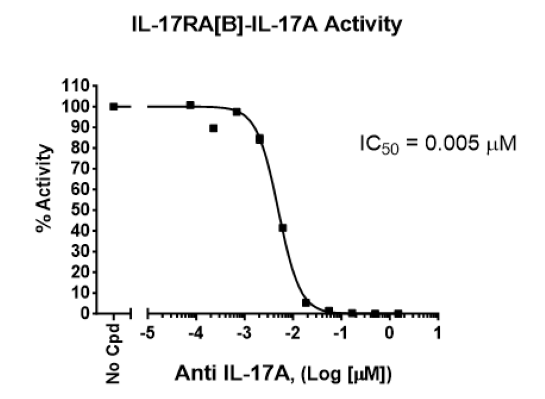IL-17RA[Biotin]:IL-17A Inhibitor Screening Assay Kit
The IL-17RA[Biotynilated]:IL-17A Inhibitor Screening Assay Kit is designed to measure the binding of IL-17RA (interleukin 17 receptor A) to IL-17A (IL-17 subunit alpha) for screening and profiling applications. The IL-17RA[Biotynilated]:IL-17A Inhibitor Screening Assay Kit comes in a convenient 96-well format, with enough recombinant purified biotinylated IL-17RA (amino acids 33-320), IL-17A (amino acids 20-155), blocking and assay buffer and detection reagents for 100 enzyme reactions.
Need us to run inhibitor screens or profile your compounds against IL-17RA[Biotin]:IL-17A? Check out our Immunotherapy Biochemical Screening Services.
- 1x PBS (phosphate buffer saline)
- Luminometer or microplate reader capable of reading chemiluminescence
- Adjustable micropipettor and sterile tips
- Rotating or rocker platform
| Catalog # | Name | Amount | Storage |
| 91013 | IL-17RA, Fc Fusion, Biotin-Labeled (Human)* | 2 µg | -80°C |
| 91014 | IL-17A, Avi-Tag* | 10 µg | -80°C |
| 79311 | 3x Immuno Buffer 1 | 50 ml | -20°C |
| 79728 | Blocking Buffer 2 | 50 ml | +4°C |
| 79742 | Streptavidin-HRP | 10 µl | +4°C |
| 79670 | ELISA ECL Substrate A (translucent bottle) | 6 ml | Room Temp |
| ELISA ECL Substrate B (brown bottle) | 6 ml | Room Temp | |
| 79699 | White 96-well microplate | Room Temp |
*The concentration of the protein is lot-specific and will be indicated on the tube.
IL-17 (interleukin 17) is a cytokine involved in inflammation and belongs to the pro-inflammatory cystine knot cytokine family. The IL-17 family includes IL-17A-F. It binds to the receptor IL-17R, which has three variants IL-17RA-C, in T helper 17 (Th17) cells in response to IL-23. It is also produced by macrophages, dendritic cells and δγ T cells. Activation of downstream pathways leads to the release of chemokines, which can recruit immune cells to inflammation sites, cytokines (such as IL-6 and GCSF (granulocyte colony stimulating factor)) and complement proteins. IL17A is also involved in differentiation of CD34+ hematopoietic progenitor cells into neutrophils. Higher levels IL17A have been linked to autoimmune disorders such as RA (rheumatoid arthritis), lupus psoriasis and asthma, transplant rejection and MS (multiple sclerosis). Inhibitors of IL-17 have been under development, as treatment options for autoimmune diseases, with the first monoclonal antibody been approved by the FDA in 2015 for the treatment of plaque psoriasis (secukinumab, sold under the commercial name of Cosentyx). The success of these drugs indicates the relevance of this cytokine in human health and disease, making it a valuable therapeutic target.
Iwakura Y., et al. 2008 Immunol Rev. 226:57-79.
Bullens D.M., et al. 2013 Clin Dev Immunol. 2013:840315.
Ley K., et al. 2006 Immunol Res. 34(3):229-42.
Tiburca L., et al., 2022 Curr Issues Mol Biol 44(5):1851-1866.


